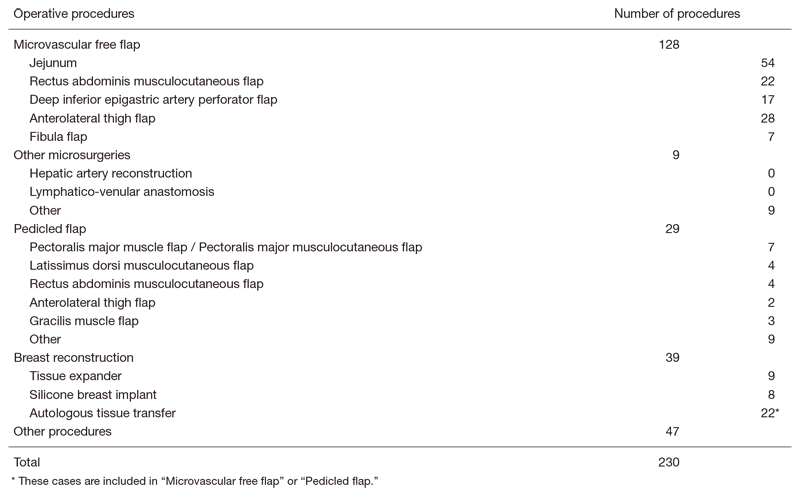Annual Report 2019
Department of Plastic and Reconstructive Surgery
Takuya Higashino, Azusa Oshima, Yutaka Fukunaga, Marie Taga, Arito Kurazono, Kazuki Shimada
Introduction
The Department of Plastic and Reconstructive Surgery has mainly focused on surgical reconstruction following cancer ablation. In our institution, reconstructive procedures using free flap transfer with microvascular anastomosis are the most important operations. In addition, several methods such as tissue transfer with pedicled flaps, local flaps, and skin grafting are used for reconstructive surgery. The objectives of reconstructive surgery are not only the morphological reconstruction, but also the restoration of postoperative functions after ablative surgery. The quality of life (QOL) of patients can be improved with functional and morphological reconstruction.
The Team and What We Do
Three plastic surgeons cover reconstructive operations in the National Cancer Center Hospital (NCCH) East in Kashiwa. The reconstructive surgeries are performed in cooperation with surgeons of other departments within the hospital, such as the Departments of Head and Neck Surgery, Breast Surgery, Esophageal Surgery, Thoracic Surgery, Colorectal Surgery, and Urology (Table 1). In the NCCH East, head and neck reconstruction is the most frequently performed operation accounting for about 50% of the reconstructive surgeries. In the head and neck region, free jejunal transfer, anterolateral thigh flap transfer, and rectus abdominis musculocutaneous flap transfer are the frequently used procedures (Table 2). A weekly conference is held with doctors of the Departments of Head and Neck Surgery, Radiation Oncology, and Head and Neck Medical Oncology. Breast reconstruction using autologous tissue transfer was employed in 2003, and since then, patients’ needs for breast reconstruction are increasing. Furthermore, lymphatico-venular anastomosis as a surgical treatment for lymphedema of the extremities was introduced in 2013.
Table 1. Number of patients (April, 2019 - March, 2020)
Table 2. Operative procedures (April, 2019 - March, 2020)

Research activities
Plastic and reconstructive surgery has focused on the following four aspects in the surgical treatment of cancer for the purpose of contributing to the improvement of the QOL of patients. 1) Obtaining good functional recovery 2) Reduction of postoperative complications 3) Achieving less donor site morbidity 4) Treatment of postoperative complications after cancer ablation. With the objective of addressing these four aspects establishing a standard for reconstructive surgery and developing new techniques of reconstructive surgery are the most important aims of our studies. In 2017, we started to take an active part in a new multi-institutional analysis of risk factors for functional outcome after tongue reconstruction.
Education
We accept a lot of young plastic surgeons from all over Japan as residents and train them to become reconstructive surgeons. We also train them to become future opinion leaders in the field of reconstructive surgery.
Future prospects
The promotion of multi-institutional studies concerning reconstructive surgery will provide our patients with high-precision medical services based on evidence.
List of papers published in 2019
Journal
1. Miyamoto S, Nakao J, Higashino T, Yoshimoto S, Hayashi R, Sakuraba M. Clavien-Dindo classification for grading complications after total pharyngolaryngectomy and free jejunum transfer. PLoS One, 14:e0222570, 2019
2. Shinozaki T, Hayashi R, Okano W, Tomioka T, Higashino T. Treatment results of 99 patients undergoing open partial hypopharyngectomy with larynx preservation. Jpn J Clin Oncol, 2019
